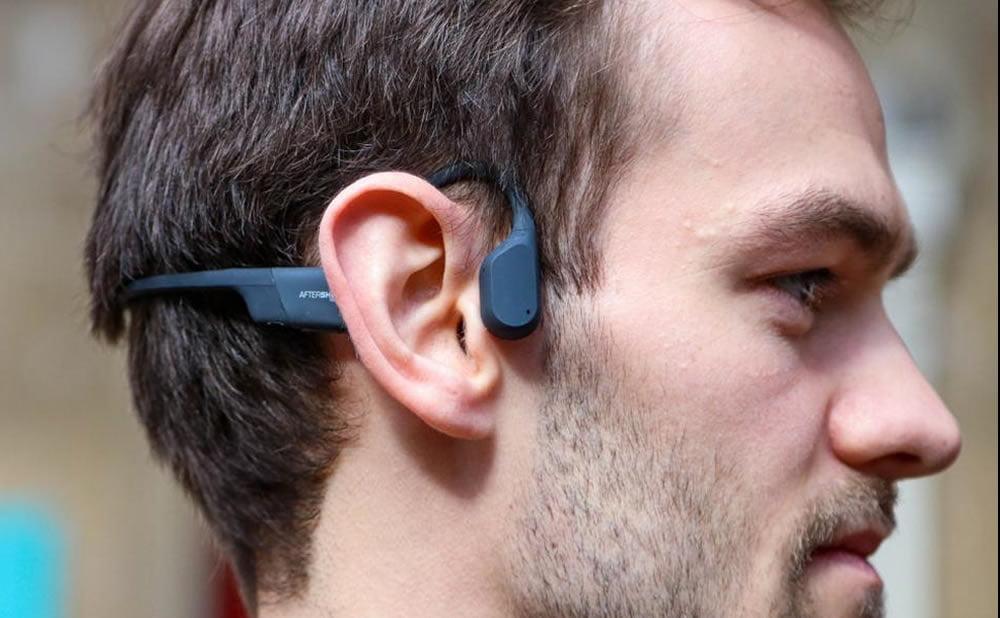Bone conduction headphones: Everything you need to know
Almost everyone uses headphones on a daily basis. However, which equipment is better to turn to? Wired, wireless or even bone conduction headphones? Innovation is in full swing in a booming sector.
Practical, innovative, expensive, revolutionary… In the field of audio headphones, superlatives are often the norm when promoting a new product or a new technology. If Apple's AirPods dominate the market in both ears, is there room for bone conduction headphones or are they just a gimmick? Update on this unknown but effective technology.
What are bone conduction headphones?
To begin with, it is necessary to explain what we are talking about when we talk about the subject of bone conduction headphones. The terminology can actually sound a bit scary. It is however a rather old technology in its use, even if of course this system has undergone radical changes over time. The idea is not to diffuse the sound directly inside the ear, but by vibration which is then conducted from the jaw to the ears.
A very distant origin!
The first to use bone conduction in a musical context is none other than Ludwig van Beethoven, the famous German composer and pianist. Once he became deaf, he wished to continue producing music. So he placed a conductive rod running from his piano to his teeth. The vibrations felt by his jaw allowed him to continue to hear and compose music despite his disability.
A passage through the army
As often afterwards, it was the army that used this technology, in particular to preserve spatial perception in tactical communications. The developments that took place then are now reverberating to the general public. Note that this is a technology that is also used massively by people with hearing impairments.
How do bone conduction headphones work?

Of course, like many people, you wonder how it can all work. A bone conduction earphone is not placed in the ear, but just above it. It emits vibrations that are felt by the bones of the jaw and on the temples. Very concretely, this allows the sound to bypass your eardrum and go directly to your inner ear (cochlear). It is a system that therefore makes it possible to circumvent any hearing problems and to restore, at least partially, hearing. It is also a technology that allows you not to isolate yourself from the environment.
Confusing at first
With bone conduction headphones, you could therefore follow (and participate in) a conversation or even listen to music, while having your ears free. What save those who are equipped for example with a hearing aid. Of course, most people are used to listening to sounds through the ear, so it can seem rather confusing at first.
What audio quality for bone conduction headphones?
Are you an aficionado of good music and this is your first criterion when choosing headphones or earphones? Then bone conduction headphones are probably not the right solution for you. Indeed, most conventional equipment offers an advantage that you will not find here: insulation. Without even going as far as specific noise reduction systems, having an earphone in the ear makes it possible to filter out some of the ambient sounds. So with a bone conduction headphone system, you won't be able to get that sound attenuation you almost forgot about.
Lower audio quality
Worse still, since your ear is not being actively used, the accuracy of the audio transmission will often drop in quality. Finally, the last parameter which can be a real negative point for some users, the comfort of use is not necessarily the same. A bone conduction earphone actually sits on the outside of your ear, not the inside. This device can leave an unpleasant feeling in the long run.
When to use bone conduction headphones?
However, it is obvious that not everything is to be thrown away in the concept of bone conduction headphones. This type of equipment has advantages in certain configurations. Thus, there are certain contexts where it becomes necessary to remain aware of your environment, of the noise that may be around you. This is the case, for example, if you jog or cycle. With bone conduction headphones, you can hear pedestrians around you, cars, or any other kind of threats that can put you at risk.
Ideal for people with hearing problems
Moreover, for people with hearing impairments, wearing conventional headphones may prove impossible, especially if they wear a specific device. In this case, bone conduction headphones are the perfect solution. A person who is deaf in one ear can still listen to music in stereo. These headphones put music within everyone's reach.
What are the best bone conduction headphones?
Many models are already available on the market, but it is clearly the Aftershokz company that dominates with the best models. Several of them thus stand out very particularly. We thus appreciate the Aftershokz Aeropex, with an autonomy of 8 hours, an IP67 resistance, the Bluetooth 5.0 connection and a rather light weight. Only downside: the price. But also the AfterShokz Xtrainerz designed for swimming.
See our selection of the best AfterShokz headphonesFinally, a third interesting model, and above all more affordable, is available from Vidonn. For a lower price, the Vidonn F1 model offers Bluetooth 5.0 connectivity and a 6-hour battery life. It is a model nevertheless more fragile and less high-end. A good alternative for those who want to have this technology with a different brand and a low price.
See our selection of the best Vidonn headphones [Total: 107 Average: 4.9]


![PAU - [ Altern@tives-P@loises ] PAU - [ Altern@tives-P@loises ]](http://website-google-hk.oss-cn-hongkong.aliyuncs.com/drawing/179/2022-3-2/21584.jpeg)

![Good deal: 15% bonus credit on App Store cards of €25 and more [completed] 🆕 | iGeneration Good deal: 15% bonus credit on App Store cards of €25 and more [completed] 🆕 | iGeneration](http://website-google-hk.oss-cn-hongkong.aliyuncs.com/drawing/179/2022-3-2/21870.jpeg)





Related Articles